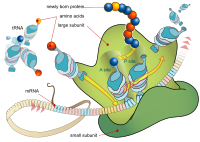
Photo from wikipedia
Translation elongation factor P (EF-P) is conserved in all three domains of life (called eIF5A and aIF5A in eukaryotes and archaea, respectively) and functions to alleviate ribosome pausing during the… Click to show full abstract
Translation elongation factor P (EF-P) is conserved in all three domains of life (called eIF5A and aIF5A in eukaryotes and archaea, respectively) and functions to alleviate ribosome pausing during the translation of specific sequences, including consecutive proline residues. EF-P was identified in 1975 as a factor that stimulated the peptidyltransferase reaction in vitro but its involvement in the translation of tandem proline residues was not uncovered until 2013. Throughout the 4 decades of EF-P research, perceptions of EF-P function have changed dramatically. In particular, while EF-P was thought to potentiate the formation of the first peptide bond in a protein, it is now broadly accepted to act throughout translation elongation. Further, EF-P was initially reported to be essential, but recent work has shown that the requirement of EF-P for growth is conditional. Finally, it is thought that post-translational modification of EF-P is strictly required for its function but recent studies suggest that EF-P modification may play a more nuanced role in EF-P activity. Here, we review the history of EF-P research, with an emphasis on its initial isolation and characterization as well as the discoveries that altered our perceptions of its function.
Journal Title: FEMS microbiology reviews
Year Published: 2020
Link to full text (if available)
Share on Social Media: Sign Up to like & get
recommendations!